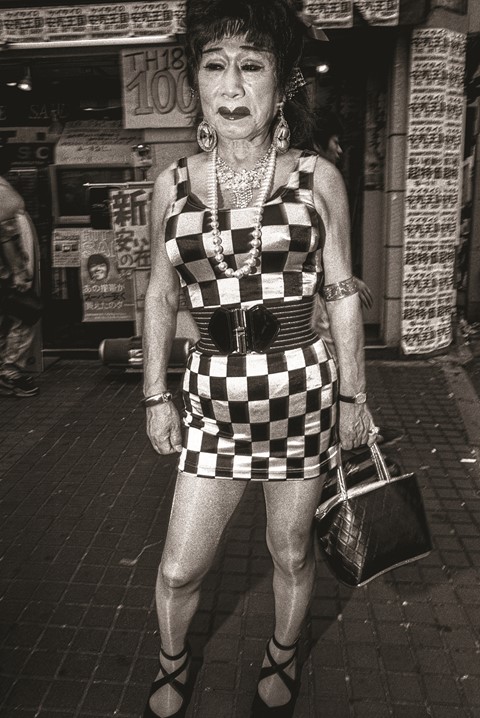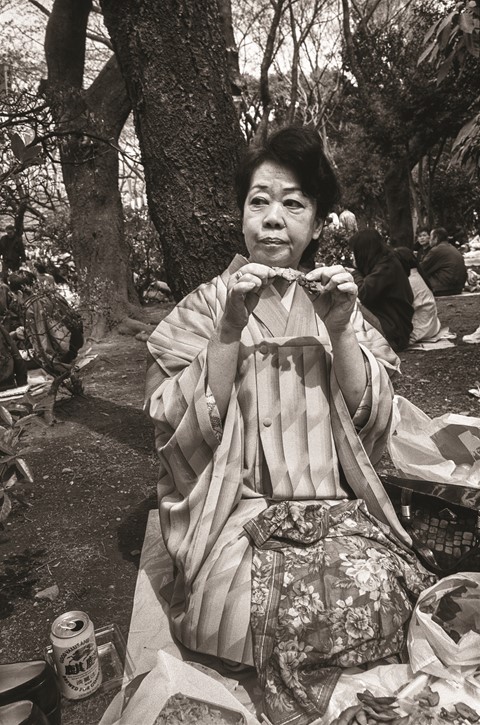The Brooklyn-born photographer’s latest publication Cherry Blossom documents subcultures in Tokyo and Osaka, including the Yakuza and a biker youth gang known as the Bosozoku
Before adulthood, we are often taught to divert our gaze on the street, whether out of politeness or to avoid potential aggression from strangers. The Brooklyn-born photographer, Bruce Gilden, doesn’t abide by these rules. Known for his arresting close-up portraits amplified in bold definition, his approach to portraiture has made the 75-year-old one of the most successful street photographers of our era.
His latest publication Cherry Blossom (Thames & Hudson) documents underground world of subcultures in Tokyo and Osaka, captured in gritty, black-and-white photographs that reveal members of the Yakuza (Japanese mafia), or the biker youth gang known as the Bosozoku.
“I don’t think any photograph is worth dying for” he tells AnOther. “But I try to do the best I can to avoid a situation with someone who might react in the wrong way. In all the years that I’ve been photographing people, I think I have a very good track record. I’m more prone to have an argument with someone without the camera.”
Gilden began photographing the streets of New York in the late 1960s, and has always been attracted to the clandestine, shadowy figures of urban life: “It’s in my soul. My father was a gangster type. Since the age of five, I always wanted to be a boxer, or was interested in the strangest looking wrestlers.”

In 1995, he travelled to Japan for the first time, inspired by the exhibition New Japanese Photography at MoMA, “it blew me away”. In Tokyo he photographed the district known as San’ya in the outskirts of the city, and also followed members of the Yakuza with an interpreter. “I have a background of not asking questions, which people in the underworld like. If you know something you could be blamed if something bad happens to them.”
Gilden doesn’t photograph individuals living and working on the fringes of ‘civilised’ society simply for the sake of it. Nor does he photograph any quirky pedestrian or passer-by. He’s looking for something specific, yet which can’t be easily defined. “I can walk into a room with a 100 people and only want to photograph two people. For me it’s a total visual thing – I’m an intuitive photographer and an intuitive person.”
Importantly, Gilden sees himself on the same level as any of his subjects, neither below or above them. “I don’t look at myself like an outsider, I see myself as an insider, whether I’m walking on the street in Japan or in Haiti.”
His talent for portraiture undeniably lies in the fact that he understands people – and most crucially – how to handle them. Despite being in his mid-70s, he hasn’t lost his sharpness, or ability to anticipate a stranger’s reaction: “If I think someone could respond in a crazy way, I give them a certain look, as if to say, we’re mates. It breaks the ice.”
“All these people say things about street photography, but they know nothing about it. I’ve worked on the street for 50 years. I know how to read people” – Bruce Gilden
He placates his subjects as quickly as he invades their personal space with his flash. Even during the course of the interview, his disarming demeanour shifts from no-bullshit toughness to charming camaraderie – and overall, one can sense that he feels misunderstood.
“All these people say things about street photography, but they know nothing about it. I’ve worked on the street for 50 years. I know how to read people, and I think I’m very streetwise and knowledgeable about people. Someone else might not be able to do the things I do without too much aggravation.”
The older he gets, the more physically challenging his profession has become. “I was never strong, but I was a fighter type, so I was comfortable out there on the streets. You have to be able to take care of yourself physically.”
Many of the best shots in Cherry Blossom were taken from unexpected angles, especially from the perspective of the ground or pavement. “I find when something is structured too perfectly it loses its punch. It becomes obvious. I like the looseness of the frame.”

But Gilden stresses that you can’t rely on sophisticated angles alone. “If the angle is not the reason why you’re looking at it – and if everything works organically in the frame and has emotional content – it has a chance of being a very good picture.”
His favourite photograph from Cherry Blossom – “one of my most iconic shots” – shows an obedient Yakuza subordinate lighting the cigarette of his machismo boss. While the angles may entice the eye, it is the distinct personalities of each of these men– combined with the visible power dynamic between them – that gives this photograph a Gildenesque “punch.”
Shomei Tomatsu, one of Japan’s greatest photographers (and whom Gilden had lunch with twice), once said: “If I had lived seven lives, I would have been a photographer every time.”
Gilden agrees, but adds “what drives me is to take the next wonderful photograph. I want to do better today than I did yesterday. But it’s tough the older you get – I don’t want to be the boxer who quits, only to come back to the ring to get knocked out.”
But it doesn’t look like Gilden has plans to slow down, or take off the boxing gloves. “If I can equal my past work I’ll be happy. I still have the passion – and that counts.”
Bruce Gilden: Cherry Blossom is published by Thames & Hudson, and is out now.
